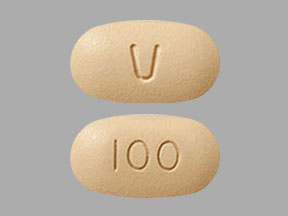Venetoclax and Alcohol/Food Interactions
There is 1 alcohol/food/lifestyle interaction with venetoclax.
Venetoclax Food/Lifestyle
Major Food Interaction
ADJUST DOSING INTERVAL: Food enhances the oral bioavailability of venetoclax. Relative to fasting conditions, venetoclax systemic exposure (AUC) increased by approximately 3.4-fold when administered with a low-fat meal (approximately 512 kilocalories, 25% calories from fat) and by 5.1- to 5.3-fold when administered with a high-fat meal (approximately 753 kilocalories, 55% calories from fat).
GENERALLY AVOID: Grapefruit, grapefruit juice, Seville oranges, and starfruit may increase the plasma concentrations of venetoclax, which is primarily metabolized by the CYP450 3A4 isoenzyme. The proposed mechanism is inhibition of CYP450 3A4-mediated first-pass metabolism in the gut wall by certain compounds present in grapefruit. Inhibition of hepatic CYP450 3A4 may also contribute. The interaction has not been studied with grapefruit juice, but has been reported with potent CYP450 3A4 inhibitors. In a study of 11 previously treated non-Hodgkin lymphoma patients, when the potent CYP450 3A4 inhibitor, P-glycoprotein (P-gp) and breast cancer resistance protein (BCRP) inhibitor ketoconazole (400 mg daily for 7 days) was coadministered with venetoclax (50 mg single dose), venetoclax peak plasma concentration (Cmax) and systemic exposure (AUC) increased by 2.3-fold and 6.4-fold, respectively. Physiologically based pharmacokinetic modeling estimates that the moderate CYP450 3A4 inhibitors diltiazem and erythromycin may increase the Cmax and AUC of venetoclax by between 1.4- to 2- fold and 2- to 4.9-fold, respectively, while the weak CYP450 3A4 inhibitors fluoxetine and fluvoxamine appear to have no significant effect on its Cmax or AUC. In general, the effect of grapefruit juice is concentration-, dose- and preparation-dependent, and can vary widely among brands. Certain preparations of grapefruit juice (e.g., high dose, double strength) have sometimes demonstrated potent inhibition of CYP450 3A4, while other preparations (e.g., low dose, single strength) have typically demonstrated moderate inhibition. Increased venetoclax exposure may potentiate the risk of tumor lysis syndrome, particularly at initiation of therapy and during the dosage ramp-up phase, as well as other adverse effects such as diarrhea, nausea, vomiting, neutropenia, anemia, and thrombocytopenia.
MANAGEMENT: Venetoclax should be administered with a meal and water at approximately the same time each day. Patients should avoid consumption of grapefruit products, Seville oranges, and starfruit during treatment with venetoclax.
References (6)
- (2016) "Product Information. Venclexta (venetoclax)." AbbVie US LLC
- (2022) "Product Information. Venclexta (venetoclax)." AbbVie US LLC
- (2023) "Product Information. Venclexta (venetoclax)." AbbVie Pty Ltd
- (2024) "Product Information. Venclyxto (venetoclax)." AbbVie Ltd
- (2022) "Product Information. Venclexta (venetoclax)." AbbVie Corporation
- Freise K.J, Shebley M, Salem A.H (2017) "Quantitative prediction of the effect of CYP3A inhibitors and inducers on venetoclax pharmacokinetics using a physiologically based pharmacokinetic model" J Clin Pharmacol, 57, p. 796-804
Switch to consumer interaction data
Venetoclax drug interactions
There are 465 drug interactions with venetoclax.
Venetoclax disease interactions
There are 4 disease interactions with venetoclax which include:
More about venetoclax
- venetoclax consumer information
- Check interactions
- Compare alternatives
- Reviews (23)
- Side effects
- Dosage information
- During pregnancy
- Drug class: miscellaneous antineoplastics
- Breastfeeding
- En español
Related treatment guides
Drug Interaction Classification
| Highly clinically significant. Avoid combinations; the risk of the interaction outweighs the benefit. | |
| Moderately clinically significant. Usually avoid combinations; use it only under special circumstances. | |
| Minimally clinically significant. Minimize risk; assess risk and consider an alternative drug, take steps to circumvent the interaction risk and/or institute a monitoring plan. | |
| No interaction information available. |
See also:
Further information
Always consult your healthcare provider to ensure the information displayed on this page applies to your personal circumstances.


